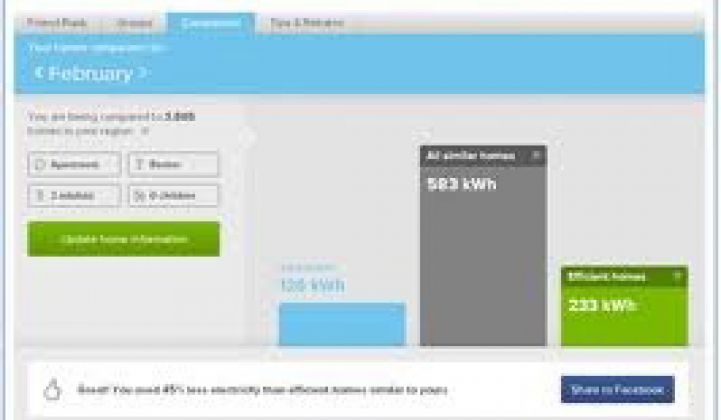For now, however, the app’s appeal to average homeowners may well depend on whether or not they happen to be a customer of one of the 16 utilities that have teamed up with the app’s “Utility Connect” feature.
That’s because customers of those utilities, which include Chicago’s ComEd, New England’s National Grid and California’s Pacific Gas and Electric Company, will be able to have their real energy data uploaded to the app in a moment’s notice, said Ogi Kavazovic, Opower’s vice president of marketing. (For a complete list of participating utilities, see below.)
Those utilities collectively serve about 20 million or so customers, or about one out of every six power customers in the United States, Kavazovic said in an interview.
But if you’re not a customer of one of those utilities, you’re going to have to type in your own power bill data to play with all the features the new app offers. That’s a step that will probably turn away most people, if the failure of Microsoft Hohm and other “type-in-your-data” home energy platforms are any indication.
Still, Tuesday’s launch opens a set of basic features to virtually anyone with a Facebook account. Those include a set of apps to share and compare one’s home energy usage and utility bill data with chosen friends or groups, allowing schools, companies and organizations to set up contests and other socially driven efficiency challenges. Startups like Simple Energy are also attracting utility customers to energy efficiency via contests, while fellow startup Efficiency 2.0 is using an online coupon approach to get people to turn off the lights when they’re not home.
Opower’s app also draws from the reams of data that the Arlington, Va.-based startup has collected from the 70 or so utilities it now serves, which collectively have about 60 million customers. That means Facebook users can see how efficient they are compared to others that share similar living space in terms of square footage, climate zone and type of heating and air conditioning, for example.
Then there are the extra features that utilities can host on their own Facebook pages, such as click-to-save rebate programs that connect customers to stores like Home Depot, the first announced partner with Opower’s Marketplace platform launched in January.
Over the coming months, Opower, Facebook and nonprofit partner Natural Resources Defense Council plan to launch new features, like connecting smart meter data and gas metering data, Kavazovic said. They’re also hearing interest from potential partners like professional sports teams, he said.
Opower could also see the breadth of utility-to-customer data connectivity expand in the months to come, he said. While the app doesn’t have any plans at present to connect to Green Button data, the emerging national standard for customer energy data, it should be simple to do so, he said. After all, many of the utilities now planning to offer Green Button data to customers, including PG&E, also happen to be Opower customers, he said.
Still, Opower has built its utility customer list by delivering energy-saving information to customers the way they’re used to getting it -- and for most of the startup’s history, that’s been by the U.S. mail. While about 13 million utility customers have access to Opower’s web portal, only about 5 percent of those customers actually log on and engage with it on a regular basis for most utilities, Kavazovic said. Still, a few of Opower’s utility customers have managed to up that percentage to about 25 percent via smart marketing and customer outreach, he added.
Facebook, which has recently driven social media platforms to outpace email service as the most common reasons for people to go online, could be a rich new environment to popularize the whole idea of paying attention to how much energy you use at home. Right now, Opower’s app only has a few hundred users -- mainly utility employees who are testing it out.
How quickly it grows is hard to predict -- but it’s likely that making access to customer data as easy as possible via Opower’s “Utility Connect” program will be a prerequisite to getting more people involved.
The complete list of participating utilities include Austin (Minnesota) Utilities, Burbank Water & Power, Connexus Energy, Consumers Energy, Glendale Water & Power, Loveland Water and Power, Owatonna Public Utilities, City of Palo Alto Utilities, PPL Electric Utilities Corp., Rochester Public Utilities, and Utilities District of Western Indiana REMC. Two more, Direct Energy and New Jersey Natural Gas, plan to roll out later this year.



